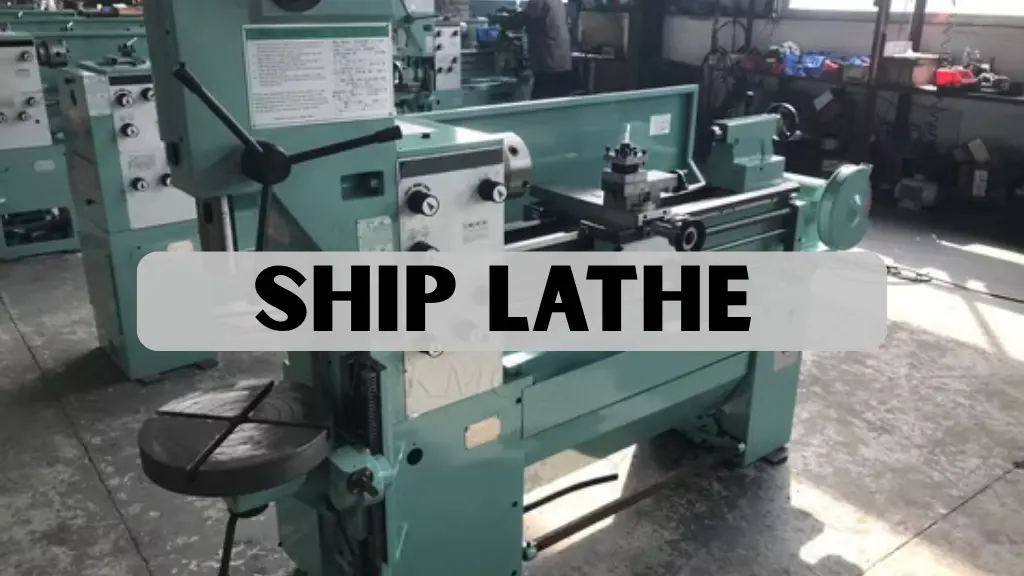A ship lathe is one of the most critical heavy-duty machines in marine workshops and shipyards, designed to handle oversized parts such as propeller shafts, rudder stocks, and rollers. Its robust construction ensures the precision and durability needed for both repair and new vessel construction, setting it apart from smaller workshop machines that lack the capacity for large-scale tasks.
In modern shipping operations, downtime can be extremely costly, making efficiency and accuracy a top priority. With the right equipment, engineers can machine massive components directly in-house, reducing delays and avoiding expensive outsourcing. This guide explores the role of advanced turning machines, their types, applications, maintenance needs, and key considerations for shipyards planning to invest in one.
What is a Ship Lathe
A ship lathe is designed to handle oversized components commonly used in vessels, such as propeller shafts and rudder stocks. Unlike traditional machines found in smaller workshops, these heavy-duty models come with extended bed lengths, high load-bearing spindles, and reinforced frames to manage extreme size and weight requirements with reliability.
Beyond standard turning operations, these machines often include functions like boring, drilling, and grinding. Their versatility allows technicians to complete complex repair or fabrication tasks in a single setup, reducing downtime and improving efficiency. Depending on operational needs, they may be manual, semi-automatic, or CNC-controlled, with CNC options offering unmatched precision and consistency for modern marine applications.
Ship vs Regular Lathe Key Differences
Although both types of machines perform turning operations, the differences between heavy-duty marine lathes and standard lathes are significant. The most obvious distinction lies in capacity. A standard machine is limited in swing and length, restricting it to smaller parts such as pulleys, shafts, and fittings. In contrast, a ship lathe is built to handle components that extend several meters and weigh multiple tonnes.
Construction also plays a major role in setting them apart. Large-capacity lathes are built with reinforced castings, durable headstocks, and wider spindle bores. They feature sturdy carriages and specially designed tailstocks for reliable support during heavy machining. Unlike lighter models that can sit on workshop floors, these machines often require dedicated foundations or reinforced flooring to manage their size and reduce vibration.
Finally, the range of applications differs considerably. While a regular lathe can manage small engineering or fabrication tasks, larger marine-focused machines are essential for ship repairs, industrial machining, and other sectors where oversized components must be restored or fabricated with high precision.
Different Types of Heavy-Duty Shipyard Lathes
Ship Lathe are available in different configurations, each designed to meet specific shipyard and workshop needs. Options include horizontal heavy-duty systems, universal and geared-head models, CNC-controlled machines, and portable on-site units. The right choice depends on component size, repair requirements, and whether work is routine or emergency-based.
Horizontal heavy-duty lathes are the most common and are specifically built for long cylindrical parts such as propeller shafts and rudder stocks. Their extended bed lengths, reinforced spindles, and steady rests provide the stability needed to handle components several meters long while maintaining precision.
Universal and geared-head machines add flexibility by offering wider speed and torque ranges. They are well-suited for both roughing and fine finishing, with some models designed as combination units for turning, drilling, and grinding in a single setup. This versatility makes them highly effective in ship repair and maintenance environments.
CNC-controlled and portable on-site lathes reflect modern advancements in marine engineering. CNC systems provide automation, accuracy, and consistency, particularly valuable in new builds or repetitive machining tasks. Portable units, on the other hand, allow machining directly on vessels or in dry docks, ensuring urgent repairs are carried out quickly without the need to transport massive components.
Key Specifications to Evaluate Before Purchase
Selecting the right shipyard lathe requires close attention to technical specifications. One of the most important factors is swing over bed, which defines the maximum diameter that can be turned. Between-centers length is equally important, as it dictates the maximum shaft length the machine can handle.
Load capacity is another major consideration. Heavy shafts weigh several tonnes, and only machines designed with sufficient spindle strength and bearing support can manage them safely. Spindle bore size and spindle speed range affect not only the size of the shafts that can be accommodated but also the quality of machining across different materials.
Other specifications include chuck size and type, tailstock travel, motor power, bed design, coolant systems, and CNC control options. Each of these influences both the performance and the suitability of the machine for specific workshop tasks.
Applications of Marine Lathes in Shipyards
These large marine turning machines are essential in many areas of ship maintenance and construction. One of their most critical roles is in the machining of propeller shafts, which often suffer from wear, ovality, or misalignment over time. Such issues can cause vibration and reduce efficiency, but with proper reconditioning, technicians can restore the correct diameter and surface finish. This process extends the shaft’s service life and helps maintain vessel performance.
Another frequent application involves the machining of rudder stocks, which demand precise turning and facing for alignment. Couplings, flanges, and collars in propulsion systems also require the accuracy delivered by this equipment. Bearings, pins, and bushings can be reconditioned to remove surface damage, while custom shafts and rollers for deck equipment are fabricated as needed.
By managing these critical tasks in-house, shipyards reduce downtime, avoid outsourcing delays, and maintain operational readiness for vessels under repair or construction.
Safety and Standards in Operations
Operating such a massive machine involves significant risks, making safety standards crucial. International standards such as ISO 23125 define protective measures, guarding requirements, and operator protocols for turning machines. Similarly, EN/IEC 60204-1 sets guidelines for the electrical safety of machine wiring and controls.
In practice, safety includes the use of fixed and movable guards around rotating parts, adherence to lockout procedures during maintenance, and training operators in both general lathe hazards and ship-specific operations. Personal protective equipment such as eye shields and hearing protection is standard, though gloves must be used with care to avoid entanglement.
By following these standards, workshops not only protect their workers but also extend the lifespan of their machines by ensuring proper usage.
Maintenance Practices for Longevity
Like all heavy machinery, this type of turning equipment requires consistent maintenance to ensure accuracy and reliability. Daily tasks typically involve cleaning chips and swarf, checking coolant levels, and ensuring that guards and shields are intact. Weekly routines include lubricating the sliding ways, inspecting belts and pulleys, and checking gearbox oil levels.
Monthly or quarterly checks involve testing spindle runout, confirming tailstock alignment, and measuring backlash in the leadscrews. These steps ensure that the lathe maintains precision even after extended use. Once a year, a comprehensive inspection should be carried out, including motor and gearbox checks, hydraulic system servicing, and alignment verification.
Consistent record-keeping of maintenance activities allows technicians to identify patterns of wear and schedule repairs before failures occur.
Buying Guide How to Choose the Right Machine
The first step in buying a shipyard lathe is defining the work envelope. This means measuring the largest diameter and length of the parts your workshop will handle and adding a safety margin. Once this capacity is clear, you can decide whether a manual or CNC option is better suited to your work.
Foundation and mobility also matter. Since these machines are extremely heavy, many require reinforced floors or custom foundations. You must also evaluate vendor support, installation services, and spare part availability. Choosing a supplier with experience in marine equipment is critical.
Finally, it is important to calculate the total cost of ownership rather than focusing only on the purchase price. Shipping, rigging, foundation construction, commissioning, operator training, and spare parts all contribute to the final expense.
New, Used, Or Rental Options
Purchasing a new marine turning machine offers warranty coverage, modern features, and dependable performance. However, the cost is high, and delivery can take months if custom specifications are required. Used lathes are available at lower prices but must be carefully inspected for wear, spindle alignment, and part availability.
For some workshops, especially those with occasional needs, renting or using mobile on-site machining services is more practical. This option reduces capital expenditure while still providing access to the necessary capacity when required.
Case Study Refurbishing a Propeller Shaft
A mid-sized ship repair yard faced the challenge of reconditioning a propeller shaft measuring over two meters in length. The shaft had worn journals and slight bending, which caused vibration at sea. The repair process began with a full inspection and measurement of runout and ovality. Once mounted on a heavy-duty marine lathe with steady rests and tailstock support, rough turning removed the damaged surface.
Precision finishing then restored the shaft to its original diameter, and final checks ensured correct tolerances. The outcome was a fully serviceable shaft that eliminated vibration and improved the vessel’s efficiency. By refurbishing rather than replacing the part, the shipyard saved both time and significant costs, while the vessel returned to service sooner.
Common Problems and Practical Solutions
Like all machines, these large-scale turning systems can develop issues over time. Excessive spindle runout is often caused by worn bearings and usually requires reconditioning or replacement. Poor surface finish may result from dull tooling, incorrect speeds, or insufficient coolant flow. Vibration during heavy cuts usually points to insufficient support, poor bed rigidity, or inadequate foundations. Electrical or CNC control problems must be diagnosed according to international safety standards and resolved by certified technicians.
How to Source Large Marine Turning Machines
Large-capacity turning machines for marine and industrial work are best sourced from specialized manufacturers with proven expertise. Reputable suppliers provide datasheets, technical specifications, and operator training to support smooth integration. Selecting a vendor with industry recognition ensures compliance with international standards. This approach reduces downtime and improves overall repair and fabrication quality.
Before purchasing, workshops should evaluate the supplier’s reputation and customer feedback. Requesting references from other facilities helps confirm reliability and service history. Warranty terms, after-sales support, and spare parts availability must also be reviewed. By working with trusted companies, buyers secure long-term efficiency and profitability.
Conclusion
A ship lathe is more than just a large turning machine; it is a vital investment for marine engineering and repair work. Shipyards use this equipment to machine oversized shafts, propellers, and rudder systems without outsourcing. Keeping the process in-house saves time, reduces transport risks, and ensures consistent quality. It also helps shipyards meet international safety standards such as ISO 23125.
From an expertise standpoint, this machinery provides long-term value by improving efficiency and cost management. Skilled operators can directly apply their knowledge to extend the lifespan of key components. Real-world repair projects demonstrate how in-house machining reduces downtime and lowers operating costs. With advanced technology and adherence to standards, it becomes a trusted asset that supports reliability and profitability in the marine industry.
FAQs
What is the difference between a ship and a marine workshop lathe
A shipyard lathe is generally a large-capacity machine designed for oversized shafts and marine parts, while a marine workshop lathe may be smaller or portable, depending on the vessel size.
Can a shipyard lathe be used for non-marine heavy work
Yes. Many industries outside shipbuilding, such as steel plants and power generation, use marine lathes for machining large rollers and industrial shafts.
Are there safety standards for lathes I must follow
Yes. ISO 23125 and EN/IEC 60204-1 are globally recognized standards that guide both mechanical and electrical safety in lathe operations.
How much does a shipyard lathe cost
Costs vary significantly, from tens of thousands of dollars for smaller universal models to hundreds of thousands for specialized heavy-duty CNC versions.
Is on-site repair a good alternative
Yes. Portable machining and mobile lathes are excellent for occasional or emergency repairs, especially when downtime must be minimized.




